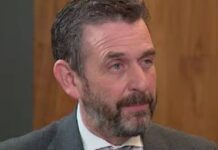
The Trump has risked America’s future. But he has surprised everyone once again.
Because President Trump is on the verge of permanently changing America with this new policy.
Trump Administration Targets Balanced Budget with Tariffs, Spending Cuts, and Court Support
President Donald Trump is pursuing an ambitious goal of balancing the federal budget, a long-standing aim of fiscal conservatives, by leveraging increased tariff revenues, implementing spending cuts through rescissions, and capitalizing on recent court decisions that enable reductions in government size.
“I’m looking at these dollars every single day, and it’s an exciting time to make sure that we are taking a crack at this $37 trillion of debt that we’re placing on the back of our children and future generations,” said Rep. Julia Letlow, R-La., a member of the House Appropriations Committee, in an interview with Just the News on Tuesday.
Letlow expressed optimism about Trump’s leadership, noting that voters “have a president that is committed to making sure that we have an America that will prosper again. He is setting us on that course. He’s done it once before. He’s doing it again.”
On Tuesday night, the Senate, with Vice President JD Vance’s support, advanced a $9 billion rescissions package to reduce federal spending, including funds for National Public Radio and PBS. The House has already passed this measure.
Recent judicial rulings are bolstering Trump’s efforts to streamline federal operations. The Supreme Court, in a 6-3 decision on Monday in McMahon v. State of New York, overturned a lower court’s injunction, allowing the administration to move forward with laying off approximately 1,400 Department of Education employees.
This ruling reversed a May decision by U.S. District Judge Myong Joun, who had argued that dismantling the Department of Education through layoffs required congressional approval and ordered the reinstatement of affected workers.
Additionally, on July 8, the Supreme Court, in another 6-3 ruling with Justice Ketanji Brown Jackson dissenting, lifted a lower court order blocking Trump’s executive order for widespread federal workforce reductions, known as “reductions in force” (RIFs).
This decision permits the administration to pursue layoffs across multiple agencies, including Commerce, Health and Human Services, Agriculture, State, Treasury, and Veterans Affairs.
The Court indicated that the administration is likely to prevail in arguing the legality of the executive order, though it has not yet ruled on the ultimate lawfulness of the layoffs. These judicial outcomes mark significant progress toward Trump’s objective of reducing the size of the federal government, bringing a balanced budget closer to reality.
The Supreme Court also authorized the Department of Government (DOGE) to use Social Security records to identify and eliminate waste, fraud, and abuse, with fewer transparency requirements, further supporting efforts to shrink federal operations.
Tariff revenues are poised to play a major role in bolstering these cost-cutting measures. As part of the recently passed “One Big, Beautiful Bill,” new tariffs have generated substantial income.
As of July 1, the U.S. has collected $106.1 billion in tariff revenue. If this trend continues, the Treasury could see an annual influx of approximately $300 billion. Rescissions are another key tool for reclaiming taxpayer funds. House Speaker Mike Johnson, R-La., and other congressional leaders have signaled that the $9 billion rescission package is just the beginning, with more savings planned.
Rep. Ralph Norman, R-S.C., a member of the Budget, Rules, and Financial Services committees, told Just The News, “We’ve got a math problem in Congress. We spend too much. I hope we can keep them [rescission packages] coming and show the American people that since we have the House, the Senate and the White House, that we mean what we say, and we’re true conservatives. I’m excited about it.”
The Rarity of U.S. Federal Budget Surpluses and Trump’s Push for Fiscal Balance
Achieving a balanced federal budget, where government revenues equal expenditures, is a rare feat in U.S. history. The last recorded surplus occurred in 2001, when the federal government posted a $128 billion surplus under President Bill Clinton, largely driven by strong economic growth and fiscal restraint following the dot-com boom.
Since then, the U.S. has faced persistent deficits, with federal spending consistently outpacing revenue. The national debt has ballooned to $37 trillion, fueled by wars, economic crises, and expansive domestic programs. According to the Congressional Budget Office (CBO), the federal deficit reached $1.8 trillion in fiscal year 2024.
Historically, surpluses are exceptional. The U.S. recorded brief surpluses from 1998 to 2001, but before that, the last surplus was in 1969, during a period of post-World War II economic stability. Over the past five decades, deficits have been the norm, with annual shortfalls often exceeding $1 trillion, particularly during economic downturns like the 2008 financial crisis and the COVID-19 pandemic.
Trump’s second-term agenda to balance the budget would mark a historic achievement. The combination of tariff revenues, projected to yield $300 billion annually, and rescissions, such as the $9 billion package recently advanced, could significantly narrow the deficit. Additionally, reducing the federal workforce, as enabled by recent Supreme Court rulings, would cut costs tied to salaries, benefits, and infrastructure.



















